 Oct. 23, 2013 May the anti-bullying force be with you, upstanding digital citizens…
Oct. 23, 2013 May the anti-bullying force be with you, upstanding digital citizens…
The month of October, once known for autumn leaves, pumpkin patches and Halloween, is now sharing time with newly fabricated monikers of bullying officialdom like Digital Citizenship Week and National Bullying Prevention Month neither of which existed a scant few years ago.
In fact, these six fabulous digital citizenship resources weren’t yet invented (or needed) much less these 60 Pinterest #DigCit posts from Edutopia or the ongoing #DigCit Twitter chats, free webinars on Empowering Students to Be Digital Citizens and so on…
In this month of bullying prevention, I’m turning the spotlight on UPSTANDING as a powerful force field for digital citizenship and community behavior online and off…
Whether it’s the Anita Sarkeesian story of standing up to sexism in video games (see Tropes, Trolls and Terrific Upstanders on Shaping Youth) or young Katie who lit up a galaxy of Star Wars support all over the world after being chided and bullied for being a girl toting her Star Wars water bottle and desire to rock a Stormtrooper costume, the UPSTANDER zeitgeist has an element of contagion.
The emergence of this powerful phenomenon as a pro-social shield is one we can all carry with us as invisible caped crusaders far beyond Halloween. Since I’m a sucker for media storytelling that flips negative societal behaviors into positive social media outcomes, today I’m talking with Carrie Goldman, (aka Star Wars’ costumed Katie’s mom) who has gleaned some valuable lessons looking back on Katie’s bullying experience three years ago which turned into what she lovingly calls the “sweetest Halloween story ever told.”
Carrie (above far right) is an anti-bullying advocate, author and fellow partner in the Times Square Take Back the Media/Brave Girls Want.com community, who admits starting out naïve and treading tenuously in the all too familiar “how do I even help her respond?” parental role of a bullied child.
Carrie immersed herself deep into the relational aggression educator sphere for answers to help her own bullied daughter, and that packs a powerful point of differentiation sharing her firsthand knowledge that proves helpful and insightful to us all.
Her ‘been there, done that’ experiential path has catapulted her in entirely new directions, including her involvement with the FIRST EVER guest panel on anti-bullying at Comic Con from coast to coast. Here’s Carrie with more:
Amy Jussel, Shaping Youth: For starters, can you recap the stellar Star Wars story of how Katie’s predicament went viral and how the Stormtrooper costume created by the 501st Legion came to be? Why do you think it resonated so much with so many? Was it the pop culture fandom, the stereotypes and gender bullying or what?
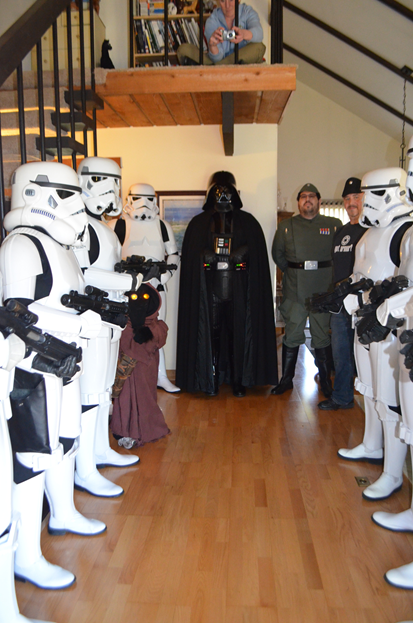 Carrie Goldman: The 501st, a charitable organization that raises millions of dollars for charity, led what I coined a cybersupporting campaign to immerse my little girl in positive messages.
Carrie Goldman: The 501st, a charitable organization that raises millions of dollars for charity, led what I coined a cybersupporting campaign to immerse my little girl in positive messages.
The 501st Legion described themselves as “The bad guys who do good” when they took up a global effort in the fall of 2010 to stick up for my young daughter, a Star Wars fan who was taunted at school by kids who claimed that “Star Wars is only for boys.”
If cyberbullying is the use of electronic media to degrade, humiliate, torment, and harass a person, then cybersupporting has emerged as the very opposite. It’s upstanding vs bystanding.
It is the use of electronic media to boost, support, inspire, and provide confidence to another person. This is what the geek community did for my then-first-grader. On Twitter, Facebook, email and even in person, they encircled her with love, affirmation and support.
That experience was the catalyst for my current work in bullying prevention — teaching kids and adults how to act as empowered allies instead of as passive bystanders. The real power lies with these witnesses.
Amy Jussel, Shaping Youth: With news media’s constant coverage of the most tragic cases of bullying, from suicides to school shootings it distorts the role of upstanding and positive practices of digital citizenship that can divert, prevent, and derail relational aggression…
Do you see our culture evolving upward with upstanding in ‘humanity rising’ mode or devolving with snark and slams mirroring pop culture’s meanness portrayed in RealityTV humiliation and such?
Carrie Goldman: Over 50% of bullying actions stop in less than 10 seconds if just one person speaks up.The hard part is getting people to overcome their fear of speaking up.
Last year, ironically, there was a widespread episode of cyberbullying that targeted the members of the 501st (in the form of a photo slideshow that ran on news websites with pictures of Star Wars fans being taunted by cruel, mocking captions).
It took far more than one person to speak up and far longer than 10 seconds before all of the news websites finally responded by pulling down the slideshow.
When my daughter learned about the situation, she wanted to show her support for her friends at the 501st by dressing up as a Stormtrooper for Halloween. That plan turned into the sweetest Halloween story ever told.
 The 501st decided to make Katie her own set of custom Stormtrooper armor, built to the exact specifications from the original Star Wars movies in the ‘70’s.
The 501st decided to make Katie her own set of custom Stormtrooper armor, built to the exact specifications from the original Star Wars movies in the ‘70’s.
People from around the world donated parts, and a special team from the Midwest Garrison assembled the armor and presented it to us in an amazing ceremony!
Not everyone has a worldwide effort like the 501st Legion to combat episodes of bullying. But everyone DESERVES the type of support we experienced.
It doesn’t have to come from thousands of strangers across the sea. It just has to come from the community in which your child lives, from the teachers and parents and students in your town.
Amy Jussel, Shaping Youth: Can you give some clear examples of upstanding vs bystanding and the role we all play as citizens, both online (digizens/digital citizenship/buzz words d’jour) and off (our communities, schools, media intake, etc.)
Carrie Goldman: If anyone still thinks the only two parties involved in bullying are the aggressors and the targets, think again. Bystander examples? Anyone who clicks “like” on vicious Facebook status updates and retweets cruel tweets are part of the problem.
In the larger media sphere, the companies that produce mounds of advertisements and products sexualizing women and children are culpable…(Amy’s note: And complicit!)
…The TV shows and movies that rely on stereotypes for cheap laughs in their story lines contribute to the problem…
…The media’s endless focus on looks (often unachievable looks, if we are accounting for photoshopped models) feeds the frenzy of entitlement that enables bullying.
Instead of searching for someone to blame, we should all acknowledge accountability and work to change our culture of cruelty. That’s upstanding!
Taking accountability means taking action, following in the footsteps of groups like SPARK Summit and Brave Girls Alliance, The Trevor Project the Anti-Defamation League, and so many others.
Amy Jussel, Shaping Youth: How can institutions like schools support upstanding beyond “feel good lip-service” and anti-bullying programs which may or may not work, depending on their efficacy as bullying prevention expert Rosalind Wiseman details in ‘what to look for’ in a solid, solutions-based PSA?
 Carrie Goldman: The problem is that bullying situations are not easy to resolve, and many educators are not adequately trained in how to respond to taunting, exclusion, name-calling, and cyberbullying.
Carrie Goldman: The problem is that bullying situations are not easy to resolve, and many educators are not adequately trained in how to respond to taunting, exclusion, name-calling, and cyberbullying.
There’s a stigma with the word bullying itself from media saturation…
The fastest way to scare off a school administrator is to say you want to talk about a bullying problem at the school. The media coverage of bullying is frequently linked to horrifying suicide stories, and schools dread the panic and liability associated with bullying situations.
Rather than calling to say that Kid A is bullying your child, try calling to discuss the behaviors of Kid A, make a written list of the specific unwanted behaviors Kid A is doing, and then request a meeting with the teacher, social worker or school principal. Bring evidence. Take photos of injuries to person or property.
If your child is being cyberbullied, take screen shots of the cruel words (and then delete that garbage from your child’s page). Block and ban the bullies after making a record of who they are and what they wrote. Download and save a copy of any YouTube videos in case the user tries to delete it later. The police can use IP addresses to figure out who the bullies are and what they wrote. If a school isn’t responding, bring the evidence to the police. Digital forensics are key, but it’s important to know what helps targets of bullying and what hurts and can escalate the problem.
Amy Jussel, Shaping Youth: Can you share specific examples of responses that HELP kids versus hinder their effort to outreach with adults? Is it a ‘Just Ask the Kids’ media lesson?
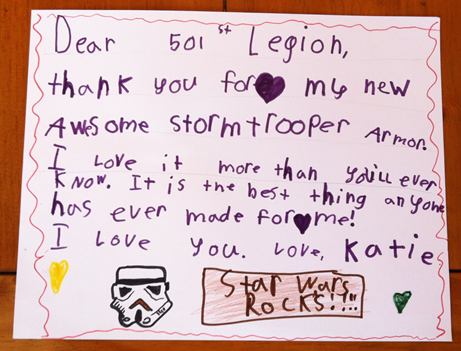 Carrie Goldman: Stan Davis and Cherise Nixon have conducted the Youth Voice Project, the first-known large-scale research project that solicits students’ perceptions about strategy effectiveness to reduce peer mistreatment in U.S. schools.
Carrie Goldman: Stan Davis and Cherise Nixon have conducted the Youth Voice Project, the first-known large-scale research project that solicits students’ perceptions about strategy effectiveness to reduce peer mistreatment in U.S. schools.
According to victimized students, the following actions by adults were most likely to make things better: “Listened to me. Checked in with me afterwards to see if the behavior stopped. Gave me advice. Kept up increased adult supervision for some time…”
…Whereas these responses by adults were most likely to make things worse: “Told me to stop tattling. Told me to solve the problem by myself. Told me if I acted differently this wouldn’t happen to me. Ignored what was going on.”
The lesson learned is adults need to check in with kids to see if the advice we give them is helping or not. Dismissive responses from adults are as harmful as no response at all, maybe even more so!
Amy Jussel, Shaping Youth: How can kids wrap their brains around the psychological damage of bullying to reframe the power of upstanding? And…
How can we culturally get past pervasive victim-blaming and flip the powerful name-calling or taunting into a healthier social emotional response rather than what brain science calls “ACEs” (Adverse Childhood Experiences)
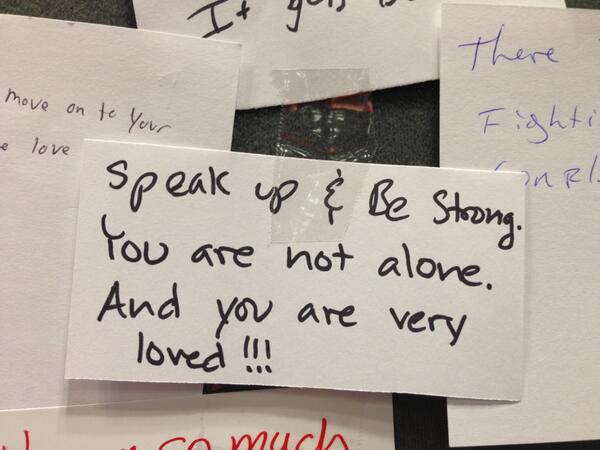 Carrie Goldman: In June, I was called in to work at a summer camp where seven year-olds were calling each other names like “Dumb Ho” and “Stupid Fag.” Seven years old!
Carrie Goldman: In June, I was called in to work at a summer camp where seven year-olds were calling each other names like “Dumb Ho” and “Stupid Fag.” Seven years old!
When I asked the kids what they thought would make them stop using those terms, one kid said very honestly, “tell those other kids not to act like dumb hos and stupid fags.” And therein lies the problem.
Every time I speak with someone who is being bullied, I ask, “Why do you think you are being bullied?” Nine times out of ten, people give answers that trouble me.
“I’m being bullied because I’m overweight.” STOP. You are being bullied because the other people are choosing to be mean, and they are using your weight to justify mistreating you. And society endorses this bullying by engaging in fat shaming and perpetuating the myth that thinner people are more valuable.
“My daughter is being bullied because she developed breasts earlier than the other girls and they are calling her slut.” NOPE. Your daughter is being bullied because the other kids are choosing to be mean, and they are using her changing body as an excuse to shame her.
 Basically, our society has done an amazing job of convincing victims that they must have done something wrong, that they must be flawed, and that is why they are being targeted. Way too much time is spent putting the burden of ending bullying on those who are targeted.
Basically, our society has done an amazing job of convincing victims that they must have done something wrong, that they must be flawed, and that is why they are being targeted. Way too much time is spent putting the burden of ending bullying on those who are targeted.
And instead of dismissing the victims of bullying as weaklings who are in need of toughening up (the favorite victim-blaming tactic of those who decry the pussification of our society), how about approaching the problem of bullying from a relational point of view?
There are multiple issues that contribute to the severity of bullying in today’s culture. Yes, we should help empower targets to stand up for themselves and teach social skills to those who struggle to fit in. But we also need to educate and teach empathy and tolerance to those who act as bullies.
Regardless of the role you play — aggressor, target or bystander –bullying is harmful to the brain. Upstanding is how we get out of this mess.
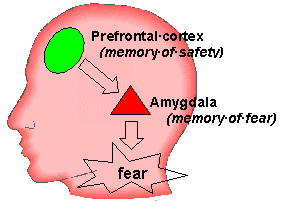 Being classified as a bully is predictive of future substance abuse, depression and anxiety. Being classified as a victim is predictive of anxiety and complex post-traumatic stress disorder. Being bullied not only causes immediate distress but also changes the way the brain works and leads to long-term difficulties for survivors.
Being classified as a bully is predictive of future substance abuse, depression and anxiety. Being classified as a victim is predictive of anxiety and complex post-traumatic stress disorder. Being bullied not only causes immediate distress but also changes the way the brain works and leads to long-term difficulties for survivors.
For example, kids who have been severely bullied can have trouble years later in the workplace, because they perceive harmless interactions as threatening. Their bodies are in a permanent state of fight or flight. And even bystanders suffer anxiety, because a human’s “ostracism detection system” becomes activated even when a person witnesses another person being ostracized. This means that we all suffer when a community is plagued by bullying. All of us.
Amy Jussel, Shaping Youth: Finally, please share the differences between upstanding for adults at events like Comic Con moderating the “End Bullying” panel (how the need came to be, and the formation of the new pop culture Anti-Bullying Coalition with Chase Masterson, etc.)
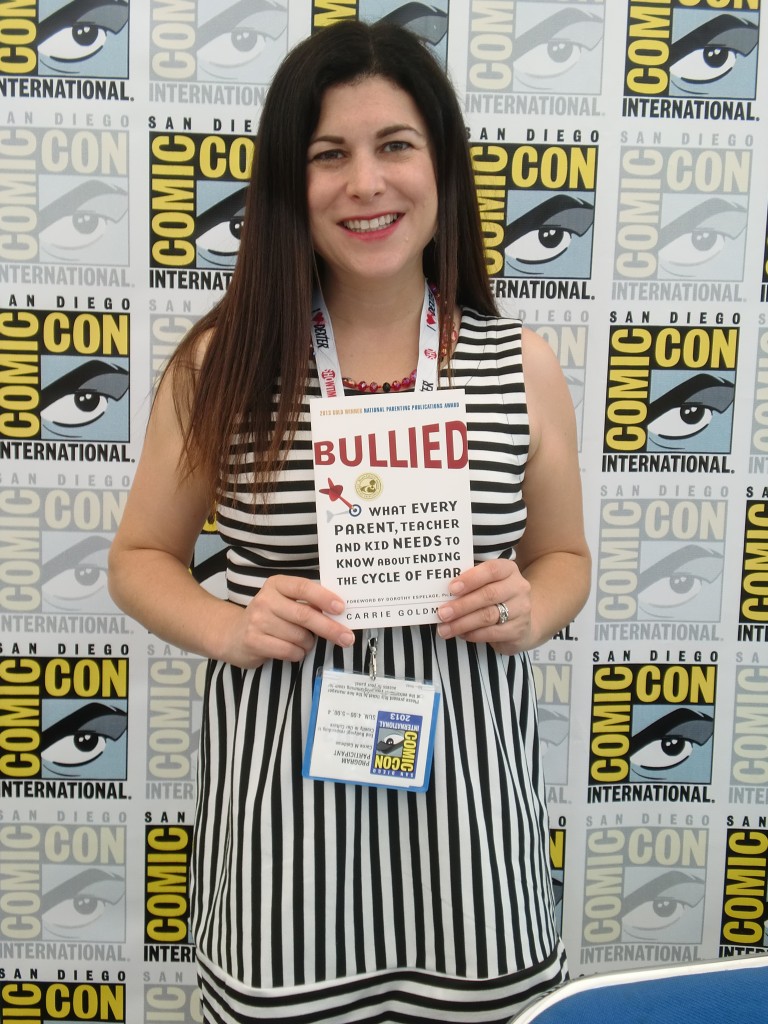 Carrie Goldman: I probably receive more emails and messages about adults being bullied than I do about kids. Nowhere was this more apparent than when I prepared to moderate an End Bullying Panel , first at San Diego Comic Con and then again at New York Comic Con.
Carrie Goldman: I probably receive more emails and messages about adults being bullied than I do about kids. Nowhere was this more apparent than when I prepared to moderate an End Bullying Panel , first at San Diego Comic Con and then again at New York Comic Con.
Within “geek culture” there is a vast amount of peer victimization, harassment and bullying. The gaming industry has been plagued by vicious attacks online and in person — male gamers versus female gamers and hardcore gamers versus casual gamers, with issues of misogyny and homophobia and discrimination coming to the forefront of our collective consciousness.
Within cosplay (costume play coinage), people attack each other over a myriad of issues — is the costume authentic or not? Does the person have the right body shape or ethnicity for the chosen costume?
These questions are met with hostility by those who seek to keep the status quo in place.
I had a few people come up to me at NY Comic-Con and try to convince me that bullying is a normal and acceptable part of society. Nope. No, it is not. It is dysfunctional and highly unacceptable.
It IS difficult to change the mindset of an adult bully. Is it possible? Yes. There is always hope that someone can learn acceptance. It helps to use restorative methods in place of punitive methods, whenever possible, and relying on social norms theory is a good way to empower bystanders to speak up.
When adults (or kids) learn that most people do not engage in bullying, they too are less likely to act as bullies. When they learn that their peers are reporting cruelty, they too are more willing to tell someone in charge if they witness bullying.
But the truth is, it is easier to inculcate kindness and empathy in children than in adults, which is why bullying prevention efforts should start as early as possible. Teaching equality to society’s youngest members is the best way reduce the number of bullies in the next generation.
Amy Jussel, Shaping Youth: Thanks, Carrie. I look forward to talking more in a separate post about Comic Con, fandom and your new “Pop Culture Anti-Bullying Coalition”…
Meanwhile, this has been a great example of media mindshifting to uplift and inspire with the lens of ‘humanity rising.’ We ALL benefit from seeing this amidst a sensationalized distorted sphere of ‘if it bleeds it leads’ media incivility and vitriol…
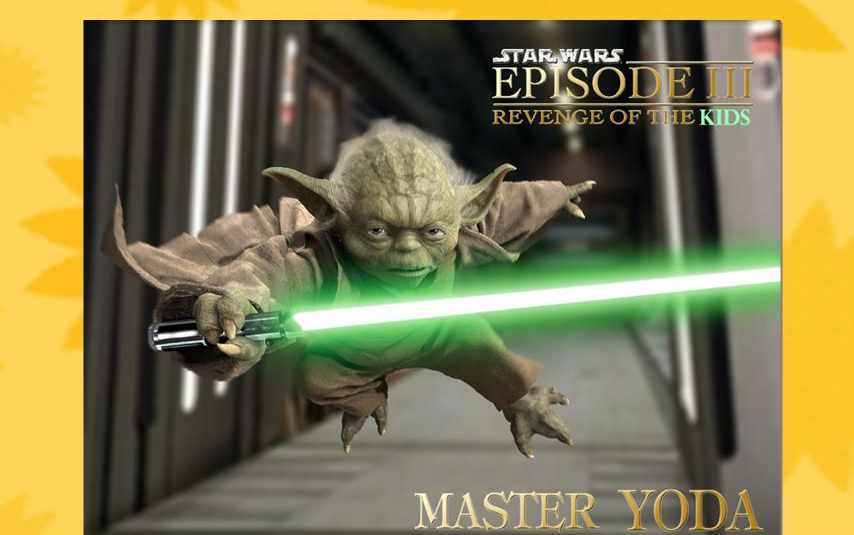 To close the conversation on UPSTANDING for now, please don’t forget to look at media making a mark in that direction…especially social media’s power to unite in ‘cyber-support’ and take action to right serious societal wrongs.
To close the conversation on UPSTANDING for now, please don’t forget to look at media making a mark in that direction…especially social media’s power to unite in ‘cyber-support’ and take action to right serious societal wrongs.
Turn your lens to the positive pushback on incivility too…From advocacy organizations that band together to support each other online and off (looking at the work of street harassment leaders like ihollaback!) to new apps like “Kindr” coming on the scene to try to leverage kindness contagion…
Of course, grassroots social justice media upstanders that prevent bullying in the form of bodysnarking by leveraging backtalking billboards also include our own partners at Brave Girls Want making a concerted global effort to upend stereotypes and gender bullying…
Yep, it’s time to salute social media upstanders, and then become one of them. Stand up, speak out, and feel the positive pull of being an UPstanding citizen. May that force be with you…Always.
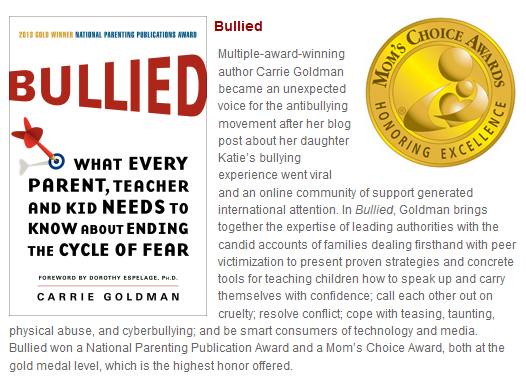 More About Bullied Author, Carrie Goldman
More About Bullied Author, Carrie Goldman
Carrie Goldman is the author of the award-winning book Bullied: What Every Parent, Teacher, and Kid Needs to Know About Ending the Cycle of Fear (Harper Collins, 2012). She also writes an internationally-followed blog called Portrait of an Adoption for ChicagoNow, the online community hosted by the Chicago Tribune.
She’s reachable on her website CarrieGoldmanAuthor.com on Twitter and Facebook and I’m proud to have had the chance to finally connect with her and share her uplifting story!
Visual credits: All photos used with permission from Carrie’s site, unless noted. NukeTheFridge.com visual of Carrie at Comic Con, and brain graphic via our friend Dr. Ellen Weber’s Brain Based Business.com; see her excellent post on bullying and links to neuroscience
Other topics you might like
|
One Response to “Upstanding Is A Force Field! Feel The Anti-Bullying Gravitational Pull”
Leave a Reply
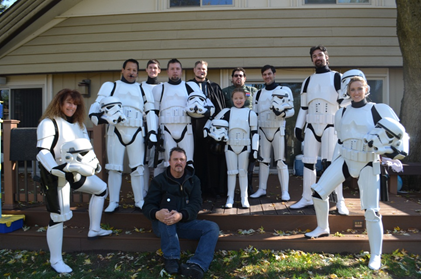
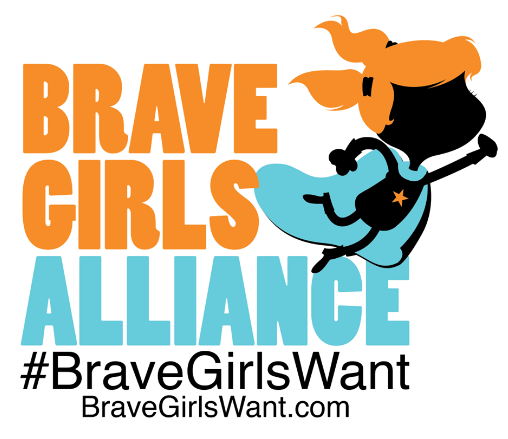
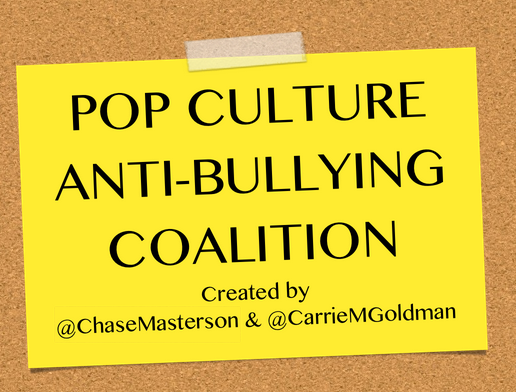
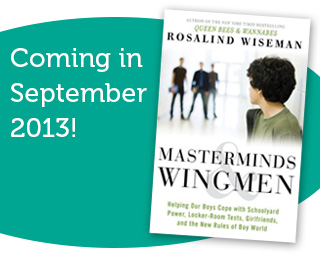

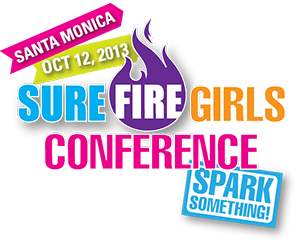
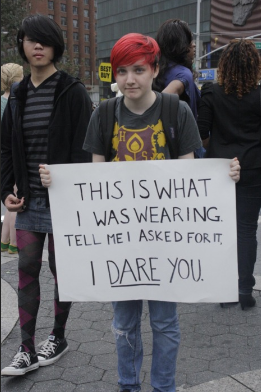








Adding this relevant “definition of bullying” taking the ABCD approach voiced by Dr. Robyn in this Good Morning America segment today hashing out a 91-zip football game with parental complaint filed that it was “bullying.”
It clearly was not. See for yourself…
http://gma.yahoo.com/video/coach-accused-bullying-team-crushes-124144239.html
Imo, the coach put in the 3rd string team before the half and wasn’t TRYING to humiliate/decimate; they were just outmatched and the coach got a bum rap. Trial by public media is outta line here, imo.
Moreover I include this specifically for the ABCD pragmatics Robyn mentions as media/pop culture reporting ends up flinging the word ‘bullying’ out there ad hoc which leads to diluted meaning.
Watch the clip specifically at 1:50-1:32 for an ABCD clarification:
“Questions to Ask About Labeling Behavior as “Bullying”
(this needs a ‘Silverman Seal’ to own these Powerful Words as part of her anti-bullying curriculum)
Copyright 2013 Dr. Robyn Silverman
I truly think that ABCD clarity should be posted in every classroom. “Bullying” is losing its ‘oomph’ by becoming a catch-all phrase.
Sure there are plenty of snarkfests, satires, and belittling in media; but is it “bullying” per se? Check the ABCDs…